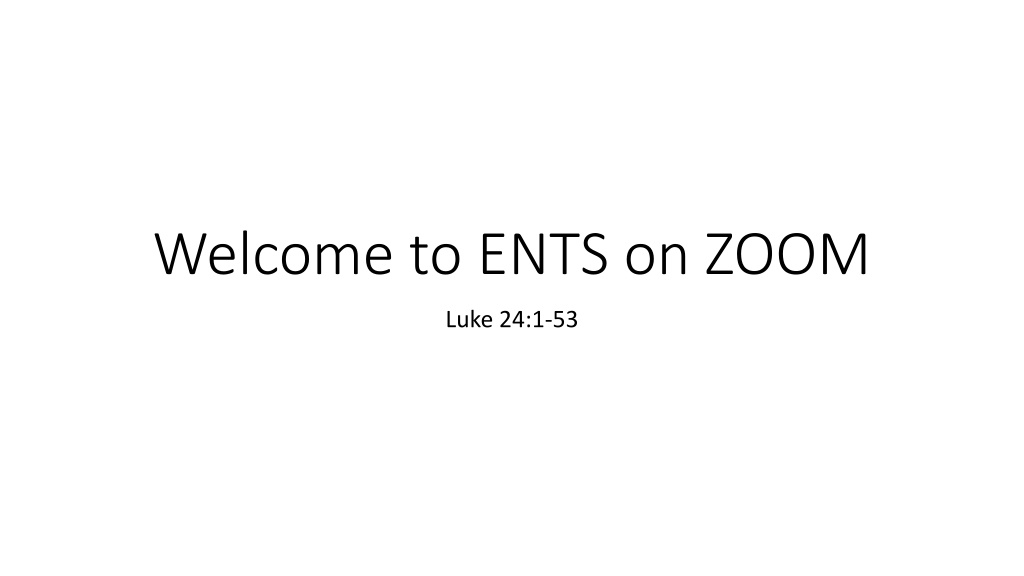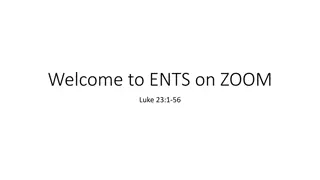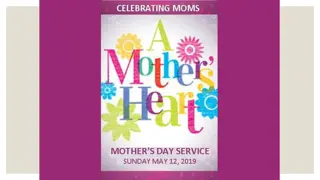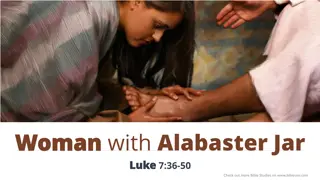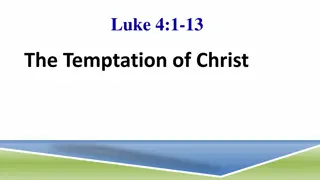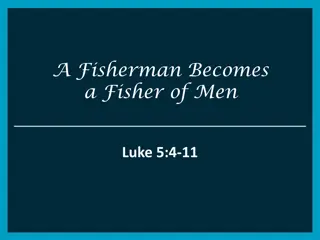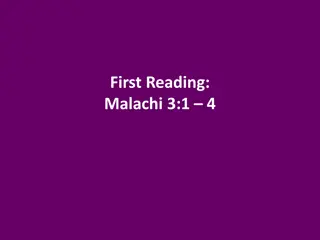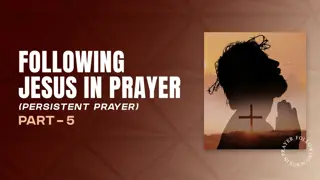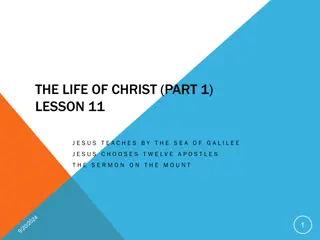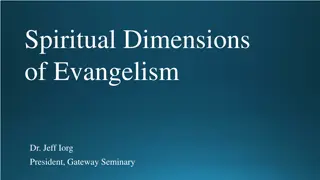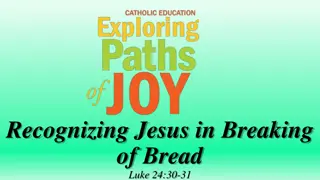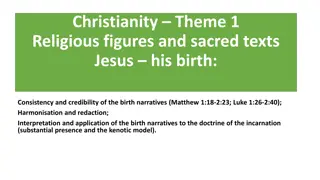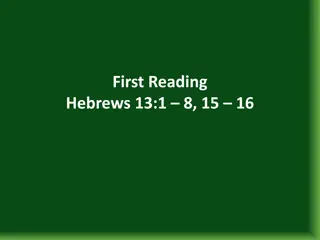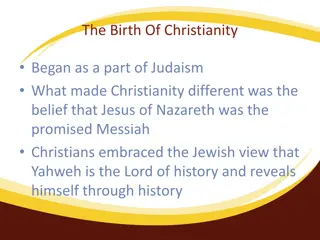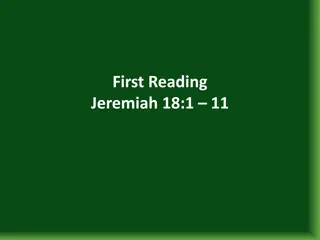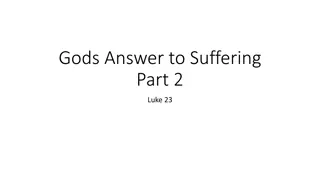The Exaltation of Jesus in Luke 24:1-53
This passage from Luke 24:1-53 discusses the exaltation of Jesus, including His resurrection, appearances to His followers, and their initial disbelief and confusion. The chapter serves as a bridge from Luke's Gospel to the book of Acts, showcasing themes of fulfillment, witness, and the ascension of Jesus. The disciples struggle to comprehend Jesus' crucifixion and resurrection until He opens their minds to understand the Scriptures, culminating in the proclamation of His resurrection to the apostles.
Download Presentation

Please find below an Image/Link to download the presentation.
The content on the website is provided AS IS for your information and personal use only. It may not be sold, licensed, or shared on other websites without obtaining consent from the author.If you encounter any issues during the download, it is possible that the publisher has removed the file from their server.
You are allowed to download the files provided on this website for personal or commercial use, subject to the condition that they are used lawfully. All files are the property of their respective owners.
The content on the website is provided AS IS for your information and personal use only. It may not be sold, licensed, or shared on other websites without obtaining consent from the author.
E N D
Presentation Transcript
Welcome to ENTS on ZOOM Luke 24:1-53
The Exaltation of Jesus (24:1-53) Among the things that Luke's Gospel has led the reader to anticipate about Jesus 3 things remain: (1) His ascension; (2) his baptism with the Spirit; (3) his return in Glory. Acts continues to nurture the third expectation, places focus on the second (Acts 2).
The Exaltation of Jesus (24:1-53) Chapter 24 focuses on the first expectation: 9:51 (Taken up), 9:31 (Exodus theme). Chapter 24 is the climax of Luke's Gospel but is not the conclusion of the Lukan Story. The Gospel is left hanging, especially God's promise to bring salvation to all peoples, the response of the people of Israel to God's visitation, the baptism of the Holy Spirit, and the anticipated coming of the Kingdom.
The Exaltation of Jesus (24:1-53) Chapter 24 is also a bridge to Acts 1. Can be seen is the tight repetition: An appearance of Jesus to his followers Jesus' eating in front of/with the disciples The prospective fulfillment of the Father's promise The description of disciples as witnesses The universal scope of the mission An account of the ascension.
The Exaltation of Jesus (24:1-53) Disciples have been unable to understand the meaning of Jesus' crucifixion and death (9:44-45; 18:31-34; cf. 24:18-21). Thus, these things are repeated, and Jesus opens their minds to understand the scriptures. Understanding and obedience are not the first response of Jesus' followers: confusion, perplexity, amazement, cynicism and unbelief, disappointment, wondering, partial joy. The disciples lack any framework to interpret what has happened.
But on the first day of the week, at early dawn, they came to the tomb, taking the spices that they had prepared. 2They found the stone rolled away from the tomb, 3but when they went in, they did not find the body. 4While they were perplexed about this, suddenly two men in dazzling clothes stood beside them. 5The women were terrified and bowed their faces to the ground, but the men said to them, Why do you look for the living among the dead? He is not here, but has risen. 6Remember how he told you, while he was still in Galilee, 7that the Son of Man must be handed over to sinners, and be crucified, and on the third day rise again. 8Then they remembered his words, 9and returning from the tomb, they told all this to the eleven and to all the rest. 10Now it was Mary Magdalene, Joanna, Mary the mother of James, and the other women with them who told this to the apostles. 11But these words seemed to them an idle tale, and they did not believe them. 12But Peter got up and ran to the tomb; stooping and looking in, he saw the linen cloths by themselves; then he went home, amazed at what had happened.
The Empty Tomb (24:1-12) This scene acts as a transition between the death and the appearances of the Risen Jesus. Tomb is the centre but is irrelevant at this stage. Both the women and Peter are yet to show faith. vv.1-3, Finding both the stone and no body. Expecting everything to be the same. Use of the designation Lord Jesus is a hint of things to come and the fact that the death of Jesus has not diminished his status. vv.4-7, Women are bewildered how to respond? The angels address the women who respond with fear and reverence. Compare with Mary at the beginning of the Gospel.
The Empty Tomb (24:1-12) God is not of the dead but the living (20:38, Sadducees). The women have failed to grasp the power of God, so their ministry is misdirected. The key to proper understanding is remembering, especially 9:22,44. 2 big changes in these texts: crucified and sinners . Women are summoned to authentic understanding and given no commission it is the understanding and acceptance of the resurrection which confirms their discipleship. vv.8-10, To remember is about understanding and insight. No need for instructions, it is done spontaneously. And the names of the women are now given, highlighting their significance. vv.11-12, Gap between male/female disciples widens. Bias against the women as witnesses. Peter's actions are significant but, while amazed, he returns home with no message.
13Now on that same day two of them were going to a village called Emmaus, about seven miles from Jerusalem, 14and talking with each other about all these things that had happened. 15While they were talking and discussing, Jesus himself came near and went with them, 16but their eyes were kept from recognizing him. 17And he said to them, What are you discussing with each other while you walk along? They stood still, looking sad. 18Then one of them, whose name was Cleopas, answered him, Are you the only stranger in Jerusalem who does not know the things that have taken place there in these days? 19He asked them, What things?
The Exaltation of Jesus (24:1-53) Disciples have been unable to understand the meaning of Jesus' crucifixion and death (9:44-45; 18:31-34; cf. 24:18-21). Thus, these things are repeated, and Jesus opens their minds to understand the scriptures. Understanding and obedience are not the first response of Jesus' followers: confusion, perplexity, amazement, cynicism and unbelief, disappointment, wondering, partial joy. The disciples lack any framework to interpret what has happened.
Encounter on the Road to Emmaus (24:13-35) The empty tomb has generated many different responses, understanding (the women); amazement (Peter) and incredulity (the rest). 1. The Journey 2. Hospitality and Table Fellowship 3. Scriptural Fulfillment
They replied, The things about Jesus of Nazareth, who was a prophet mighty in deed and word before God and all the people, 20and how our chief priests and leaders handed him over to be condemned to death and crucified him. 21But we had hoped that he was the one to redeem Israel. Yes, and besides all this, it is now the third day since these things took place. 22Moreover, some women of our group astounded us. They were at the tomb early this morning, 23and when they did not find his body there, they came back and told us that they had indeed seen a vision of angels who said that he was alive. 24Some of those who were with us went to the tomb and found it just as the women had said; but they did not see him. 25Then he said to them, Oh, how foolish you are, and how slow of heart to believe all that the prophets have declared! 26Was it not necessary that the Messiah should suffer these things and then enter into his glory? 27Then beginning with Moses and all the prophets, he interpreted to them the things about himself in all the scriptures.
28As they came near the village to which they were going, he walked ahead as if he were going on. 29But they urged him strongly, saying, Stay with us, because it is almost evening and the day is now nearly over. So he went in to stay with them. 30When he was at the table with them, he took bread, blessed and broke it, and gave it to them. 31Then their eyes were opened, and they recognized him; and he vanished from their sight. 32They said to each other, Were not our hearts burning within us while he was talking to us on the road, while he was opening the scriptures to us? 33That same hour they got up and returned to Jerusalem; and they found the eleven and their companions gathered together. 34They were saying, The Lord has risen indeed, and he has appeared to Simon! 35Then they told what had happened on the road, and how he had been made known to them in the breaking of the bread.
Encounter on the Road to Emmaus (24:13-35) vv.13-16, two of them from the group of doubters. These things - the problem of interpretation. Going to Emmaus a sign of the division alluded to in vs.11. vv.17-19, Jesus is the stranger or foreigner he knows all but is seen as not knowing. vv.19-24, these things are now given meaning. Jesus, like Moses, powerful in word and deed.
Encounter on the Road to Emmaus (24:13-35) They are incapable of understanding the meaning of the death of Jesus. People over and against the chief priests and leaders. They are only able to think of Jesus as a prophet. The third day recalls Jesus' predictions of his passion. Some gives a sense of greater openness to the word of the women than was first narrated. Redemption of Israel still an open question. Women are still the only ones to understand. vv.25-27, Foolish lack of understanding. Slow of heart failure to orientate themselves fully around Jesus' teaching.
Encounter on the Road to Emmaus (24:13-35) Heart inner commitments, dispositions and attitudes. vs.26 is the central question. The pattern exercised by Moses and the Prophets is brought to fulness by the suffering Messiah. And this bringing to fulness is both humble and totally dependent on the power of God and is consistent with the divine will. vv.28-32, Will these disciples recognise Jesus? Took bread, blessed and broke it and gave it to them (similar to 9:16, feeding gospel).
Encounter on the Road to Emmaus (24:13-35) Prior to that miraculous meal there were many misconceptions about Jesus. The disciples' condition of not being able to see is reversed their eyes were opened in the breaking of the bread. open the scripture to us. vv.33-35, From depression to excitement and energy. They respond, like the women. Lord the crucifixion is no block to Jesus being understood as the generous gift of God. How did Jesus appear Peter? Breaking of the bread provides the bridge from Jesus' practice and what will emerge in the Book of Acts.
The Appearance to the Disciples (24:36-49) The prophesy of 9:22, The Son of Man must undergo great suffering, and be rejected by the elders, chief priests, and scribes, and be killed, and on the third day be raised. finds its fulfillment in this scene, what was to happen on the third day - yet still the disciples are trapped in fear and doubt. Resurrection => not a resuscitation of corpse or an ethereal (ghost like) event. Jesus' disciples are now cast as witnesses of salvation going out to all people. Jesus' actions have been empowered by the Holy Spirit that is now promised to the disciples. Disciples doubt must be overcome: 2 material acts (touching and eating) and scriptural interpretation.
36While they were talking about this, Jesus himself stood among them and said to them, Peace be with you. 37They were startled and terrified, and thought that they were seeing a ghost. 38He said to them, Why are you frightened, and why do doubts arise in your hearts? 39Look at my hands and my feet; see that it is I myself. Touch me and see; for a ghost does not have flesh and bones as you see that I have. 40And when he had said this, he showed them his hands and his feet. 41While in their joy they were disbelieving and still wondering, he said to them, Have you anything here to eat? 42They gave him a piece of broiled fish, 43and he took it and ate in their presence.
44Then he said to them, These are my words that I spoke to you while I was still with you that everything written about me in the law of Moses, the prophets, and the psalms must be fulfilled. 45Then he opened their minds to understand the scriptures, 46and he said to them, Thus it is written, that the Messiah[n] is to suffer and to rise from the dead on the third day, 47and that repentance and forgiveness of sins is to be proclaimed in his name to all nations, beginning from Jerusalem. 48You are witnesses of these things. 49And see, I am sending upon you what my Father promised; so stay here in the city until you have been clothed with power from on high.
The Appearance to the Disciples (24:36-49) vv.36-37, Recognise but not ready to accept. Peace = Shalom, Is an alternative world for salvation in Luke's Gospel. (1:79; 2:14, 29; 7:50; 8:48; 10:5-7; 19:38). Shalom is conveyed in the context of fear, if not panic. vv.38-43, Frightened 1:12, 18-20. doubt typical of Jesus' opponents and those who fail to understand the message.
The Appearance to the Disciples (24:36-49) Jesus is presented as alive, beyond the grave as an embodied person not a ghost nor a corpse. It is I Seeing the importance of true understanding, ate in their presence important for later witness (cf. vs.48) Yet this is not enough there is still an ambiguous response.
The Appearance to the Disciples (24:36-49) vv.44-49, Opens their minds ties the history of Israel to Jesus' own story. Suffer the stumbling point for the disciples a redefinition of status before God. Being faithful to the divine will. The importance of Jesus' words is that the truth of the whole of Scriptures has now come true.
The Appearance to the Disciples (24:36-49) Repentance will become a key term to describe the appropriate response to the offer of salvation, and the re-alignment of one's life towards God's purpose. Witnesses of these things => the suffering, death and resurrection. Disciples are to be transformed eyes opened. Clothed with power from on high a reference to the coming of the Spirit. Remain in Jerusalem: disciples have already begun to splinter
The Ascension of Jesus (24:50-53) Since 9:51, Luke has been preparing his readers for Jesus' departure. lead out Jesus' role as leader is affirmed. Who is with him? The women (vs.10) the apostles and all the rest (vs.9-10). Acts 1:12-15, Mary the Mother of Jesus and his brothers (approximately 120 persons)
The Ascension of Jesus (24:50-53) Bethany the place where the triumphal entry into Jerusalem started. (Act 1:9-12) Blessing of the Disciples = An act of leave taking like Moses (Deuteronomy 33) and Abraham (Genesis 49). Highlights vs.44-49 as Jesus' last words witnesses to the nations. Away and up a royal image that acts to give meaning to the coming of the Spirit
50Then he led them out as far as Bethany, and, lifting up his hands, he blessed them. 51While he was blessing them, he withdrew from them and was carried up into heaven. 52And they worshiped him, and returned to Jerusalem with great joy; 53and they were continually in the temple blessing God.
Disciples Response 1. Worship Jesus, behave in a way that is unparalleled in Luke. Until now people have worshiped God on account of Jesus' actions. 2. Bless God render to God grateful thanks for his manifesting his divine purpose, something only a foreign leper has done so far (17:16) That leper saw what Jesus had done for him. That is to say, the disciples have finally recognised who Jesus is.
Disciples Response 3. Return to Jerusalem and in the temple the disciples remember Jesus words and act on them constant presence in the temple is like Anna who was there day and night (2:37) 4. Earlier joy which produced astonishment and disbelief gives way to great joy - the joy of those who have come to understand the divine initiative in their lives
Disciples Response Joy and praise are now found with the disciples, as was found at the beginning of the story with the birth of Jesus. The disciples now understand the salvation being offered to them they wait now to be empowered by the Spirit of God to become witnesses of that salvation.
